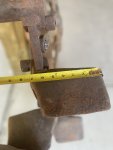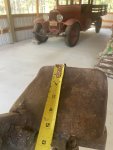I picked these up for yard art, as they are very ornate. They look somewhat like JD B wheels from the 20’s-30’s but I have not found these on a tractor anywhere. Hope someone here can help me identify them. After pressure washing them, there was some red paint a few layers down. I would estimate them as 100


 or so years old.
or so years old.
Looking for info on these Antique Steel Wheels
- Thread starter bearskinner
- Start date
Just an fyi, they’re 60” tall, and weigh over 500 pounds. 6 spline, and the bolt on cleats( hollow ) are approximately 7” wide by 5.5” tall.
Attachments
-
279.6 KB Views: 113
-
431.8 KB Views: 118
I don’t have any specifics on the application. Are you sure that wheel was used for motivation if a vehicle?
The teeth look like they would only be intended to turn one direction. And there is nothing to keep the rim from sinking in like a pizza cutter. I’m thinking that wheel didn’t come off of a tractor that runs on the ground.
The teeth look like they would only be intended to turn one direction. And there is nothing to keep the rim from sinking in like a pizza cutter. I’m thinking that wheel didn’t come off of a tractor that runs on the ground.
fried1765
Well-known member
Equipment
Kubota L48 TLB, Ford 1920 FEL, Ford 8N, SCAG Liberty Z, Gravely Pro.
Very nice yard art!I picked these up for yard art, as they are very ornate. They look somewhat like JD B wheels from the 20’s-30’s but I have not found these on a tractor anywhere. Hope someone here can help me identify them. After pressure washing them, there was some red paint a few layers down. I would estimate them as 100 View attachment 106792 View attachment 106793 View attachment 106794 or so years old.
As heavy duty as these are built, they must have carried some weight, or needed the strength for something. They look Almost like old JD wheels.


Runs With Scissors
Well-known member
Equipment
L2501 TLB , Grappel, Brush Hog, Box Blade, Ballast box, Forks, Tiller, PH digger
Very cool looking.
I'm leaning towards this is one of 5 or 6 (more?) on a single axle.
Kind of like a paddle wheel boat, but for some sort of tractor like machine.
Edit: Darn it.....BearSkin for the win......There goes my paddle wheel idea......
I agree.The teeth look like they would only be intended to turn one direction.
I'm leaning towards this is one of 5 or 6 (more?) on a single axle.
Kind of like a paddle wheel boat, but for some sort of tractor like machine.
Edit: Darn it.....BearSkin for the win......There goes my paddle wheel idea......
Well, those look a lot like the yard art. There goes my lack of rim width justification.As heavy duty as these are built, they must have carried some weight, or needed the strength for something. They look Almost like old JD wheels.
View attachment 106806 View attachment 106807
According to SGOTI, in 1935 only 15% of tractors had rubber tires. By 1940, 95% did. I think I've read that during WWII some tractors reverted to steel, due to rubber being rationed. My Dad and an uncle had Farmall F20's with steel wheels, but I never saw either one run. They started on gasoline, then switched over to distillate (tractor fuel) or kerosene.
North Idaho Wolfman
Moderator
Staff member
Lifetime Member
Equipment
L3450DT-GST, Woods FEL, B7100 HSD, FEL, 60" SB, 743 Bobcat with V2203, and more
Based on our location I'm betting those wheels were used on logging equipment.
Or possibly peat moss operations.
Or possibly peat moss operations.
They came out of Chewelah Wa, which is originally a mining operation, at the base of the Ski Resort. There is lots of farming in the surrounding areas though.
I’ve pressure washed them a couple times now, blowing off lots of moss and grime. I can detect a little residual Red paint under 100 years of crud. I thought I might find some original Yellow, but…..
I’ve pressure washed them a couple times now, blowing off lots of moss and grime. I can detect a little residual Red paint under 100 years of crud. I thought I might find some original Yellow, but…..
RCW
Well-known member
Lifetime Member
Equipment
BX2360, FEL, MMM, BX2750D snowblower. 1953 Minneapolis Moline ZAU
@bearskinner - I’m making some wild guesses; thinking your 100 year old estimate is pretty close, but I’m thinking a little short.
I’ve seen that cleat design many times on row crop tractors like the JD B you pictured. I think they had a 34-38” (?) wheel with rubber tires….equates to nearly 60” total height, but not quite. Our JD B started on steel but that was long before my days with it.
Those wheels also didn’t need to be that heavily built as the tractors were small horsepower and only weighed 5,000 pounds or so…
Now in the early, early 20th century “Prairie Busters” began to show up mostly in the Midwest.
Some steam, some fuel powered with exposed valves, governors, etc.
Some of the steam machines were as big as a small house and weighed 30,000+ pounds. Wheels often looked like that, but were 7-8 feet tall.
Shortly thereafter, some makers made smaller machines to accommodate smaller operations. I think still hefty at 10-20,000 pounds. I’m thinking pre-WWI, but again guessing. Your 60” wheel sounds more-suited to the “smaller” machines, even though they were still quite large.
Some of those tractors had an exposed ring gear on the axle, inboard to the wheel, driven by a pinion to put power to the ground.
The splined axle caught my attention. Not sure how that final drive system worked, but a splined axle would make sense. I’m assuming the ring gear and wheel were separate…not sure that is correct, but again guessing.
Rumley-Oil Pull is the first manufacturer that comes to mind, but there’s several others. All very, very rare today.
Again, I may be WAY off, but you might have a matched-set treasure. Those look pristine but for some rust.
I would look earlier in your research and best of luck finding an answer!
I’ve seen that cleat design many times on row crop tractors like the JD B you pictured. I think they had a 34-38” (?) wheel with rubber tires….equates to nearly 60” total height, but not quite. Our JD B started on steel but that was long before my days with it.
Those wheels also didn’t need to be that heavily built as the tractors were small horsepower and only weighed 5,000 pounds or so…
Now in the early, early 20th century “Prairie Busters” began to show up mostly in the Midwest.
Some steam, some fuel powered with exposed valves, governors, etc.
Some of the steam machines were as big as a small house and weighed 30,000+ pounds. Wheels often looked like that, but were 7-8 feet tall.
Shortly thereafter, some makers made smaller machines to accommodate smaller operations. I think still hefty at 10-20,000 pounds. I’m thinking pre-WWI, but again guessing. Your 60” wheel sounds more-suited to the “smaller” machines, even though they were still quite large.
Some of those tractors had an exposed ring gear on the axle, inboard to the wheel, driven by a pinion to put power to the ground.
The splined axle caught my attention. Not sure how that final drive system worked, but a splined axle would make sense. I’m assuming the ring gear and wheel were separate…not sure that is correct, but again guessing.
Rumley-Oil Pull is the first manufacturer that comes to mind, but there’s several others. All very, very rare today.
Again, I may be WAY off, but you might have a matched-set treasure. Those look pristine but for some rust.
I would look earlier in your research and best of luck finding an answer!
Last edited:
Might want to post photos on YT.I picked these up for yard art, as they are very ornate. They look somewhat like JD B wheels from the 20’s-30’s but I have not found these on a tractor anywhere. Hope someone here can help me identify them. After pressure washing them, there was some red paint a few layers down. I would estimate them as 100 View attachment 106792 View attachment 106793 View attachment 106794 or so years old.
Suggest Tractor Talk page.
Yesterday's Tractors - Discussion Forums (yesterdaystractors.com)
Magicman
Well-known member
Lifetime Member
Equipment
M4900 Utility Special 4WD e/w FEL & 1530 John Deere "Traveling Man"
I have a similar set (4) that fits an 8N Ford. They were used when initially clearing land for pastures. No flats from Honey Locust thorns.
Last edited:
Bingo.I have a similar set (4) that fits an 8N Ford. They were used when initially clearing land for pastures. No flats from Black Locust thorns.
Neighbor once had an AC WD-45 with full steel that he used to bush hog in areas with honey locust trees.



